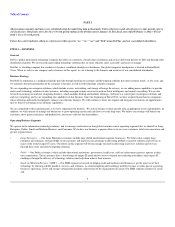Dell 2011 Annual Report Download - page 16
Download and view the complete annual report
Please find page 16 of the 2011 Dell annual report below. You can navigate through the pages in the report by either clicking on the pages listed below, or by using the keyword search tool below to find specific information within the annual report.
Table of Contents
ITEM 1A — RISK FACTORS
Our business, operating results, financial condition, and prospects are subject to a variety of significant risks, many of which are beyond our control. The
following is a description of some of the important risk factors that may cause our actual results in future periods to differ substantially from those we
currently expect or seek. The risks described below are not the only risks facing us. There are additional risks and uncertainties not currently known to us or
that we currently deem to be immaterial that also may materially adversely affect our business, operating results, financial condition, or prospects.
•We face intense competition, which may adversely affect our industry unit share position, revenue, and profitability.
We operate in an industry in which there are rapid technological advances in hardware, software, and service offerings, and we face aggressive product and
price competition from both branded and generic competitors. We compete based on our ability to offer to our customers competitive integrated solutions that
provide the most current and desired product and services features. We expect that competition will continue to be intense, and there is a risk that our
competitors' products may be less costly, provide better performance or include additional features when compared to our products. Additionally, there is a
risk that our product portfolios may quickly become outdated or our market share may quickly erode. Moreover, our efforts to balance our mix of products
and services to optimize profitability, liquidity, and growth may put pressure on our industry position.
In addition to competitive factors we face as a result of the current state of our business and our industry, we confront additional competitive challenges as our
business and industry continue to grow and evolve. As we expand globally, we may see new and increased competition in different geographic regions.
Moreover, the generally low barriers to entry in our business increase the potential for challenges from new industry competitors. We may also see increased
competition from new types of products as the options for mobile and cloud computing solutions increase. Further, as our industry evolves and our company
grows, companies with which we have strategic alliances may become competitors in other product areas or our current competitors may enter into new
strategic relationships with new or existing competitors, all of which may further increase the competitive pressures we face.
•Our reliance on vendors for products and components, many of whom are single-source or limited-source suppliers, could harm our business by
adversely affecting product availability, delivery, reliability, and cost.
We maintain several single-source or limited-source supplier relationships, either because multiple sources are not readily available or because the
relationships are advantageous to us due to performance, quality, support, delivery, capacity, or price considerations. If the supply of a critical single- or
limited-source product or component is delayed or curtailed, we may not be able to ship the related product in desired quantities, configurations, or in a timely
manner. Even where multiple sources of supply are available, qualification of the alternative suppliers and establishment of reliable supplies could result in
delays and a possible loss of sales, which could harm our operating results.
We obtain many of our products and all of our components from third-party vendors, many of which are located outside of the U.S. In addition, significant
portions of the products we sell are now assembled by contract manufacturers, primarily in various parts of Asia. A significant concentration of this
outsourced manufacturing is currently performed by only a few of our contract manufacturers, often in single locations. We sell components to these contract
manufacturers and generate large non-trade accounts receivables, an arrangement that presents a risk of uncollectibility if the financial condition of a contract
manufacturer should deteriorate.
While these relationships generate cost efficiencies, they reduce our direct control over production. Our increasing reliance on these vendors
subjects us to a greater risk of shortages, and reduced control over delivery schedules of components and products, as well as a greater risk of increases in
product and component costs. Because we maintain minimal levels of component and product inventories, a disruption in component or product availability
could harm our financial performance and our ability to satisfy customer needs. In addition, defective parts and products from these vendors could reduce
product reliability and harm our reputation.
•If we fail to achieve favorable pricing from our vendors, our profitability could be adversely affected.
Our profitability is affected by our ability to achieve favorable pricing from our vendors and contract manufacturers, including through negotiations for
vendor rebates, marketing funds, and other vendor funding received in the normal course of business. Because these supplier negotiations are continuous and
reflect the ongoing competitive environment, the variability in timing and amount of incremental vendor discounts and rebates can affect our profitability.
These vendor programs may change periodically, potentially resulting in adverse profitability trends if we cannot adjust pricing or cost variables. Our inability
to establish a cost and product advantage, or determine
14
























